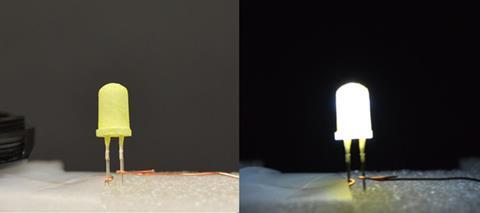Luminescent metal–organic framework films may supplant expensive, rare earth-based LED coatings

The cost of white LED lighting may be set to fall as scientists in the US have created an LED coating made from a relatively cheap luminescent metal–organic framework (MOF). The film may supplant current white LED coatings, which consist of far more expensive rare earth elements.
Modern LED technologies are being touted as the next leap forward in solid state lighting, and offer a more efficient alternative to common incandescent or halogen light bulbs. ‘You can see LEDs everywhere,’ said Zhichao Hu from Rutgers University, speaking at the 250th ACS National Meeting & Exposition in Boston, US. ‘But not a lot of us know how to make a white LED.’
The problem, explained Hu, is that a pure, white LED does not exist, you have to combine different colour LEDS, for example red, green and blue, in order to generate the desired soft white light. This increases production costs, but there is an alternative. Rather than using a multi-chip LED, engineers can use a single blue chip, whose light is converted to white via a yellow phosphor coating.
Phosphors are any substance that luminesces when exposed to light. In a phosphor-based white LED, this film normally consists of a rare earth element, such as yttrium or europium, which presents a problem. The clue is in the name of these elements, according to Hu.
‘If you look at three key ingredients of commercially available phosphors, for example yttrium, europium and terbium, the price of these … elements went [through] the roof in the last decade,’ Hu said. ‘From 2001 to 2011, the prices of yttrium, europium and terbium went up by 400%, 600% and 1600%.’
In order to reduce the cost of phosphors on the market, Hu and his colleagues looked for alternatives to rare earth element-based coatings and settled on organo-luminescent molecules. The team combined a common molecular chromophore, tetrakis(4-carboxyphenyl)ethylene, with zinc cations to produce a luminescent MOF.
When exposed to blue light, the MOF demonstrates a similar level of performance to commercially available yttrium garnet coatings. ‘The emission spectra almost overlap, which is phenomenal because we just made a compound free of rare earth elements,’ said Hu.
The coating can also be tuned to produce white light of different wavelengths as the chromophore’s structure can be modified, making it more adaptable than rare earth element-based coatings.
Although it remains to be seen how this new coating will be inserted into current white LED manufacturing operations, Hu is hopeful that it should be relatively simple given the mild conditions in which the luminescent MOF was produced. ‘A lot of the commercially available phosphors … are solid-state compounds, meaning that they need high temperature to form the structure,’ he explained. ‘We have phosphors synthesised under room temperature, so you only need to mix the ingredients and give it a stir.’












No comments yet